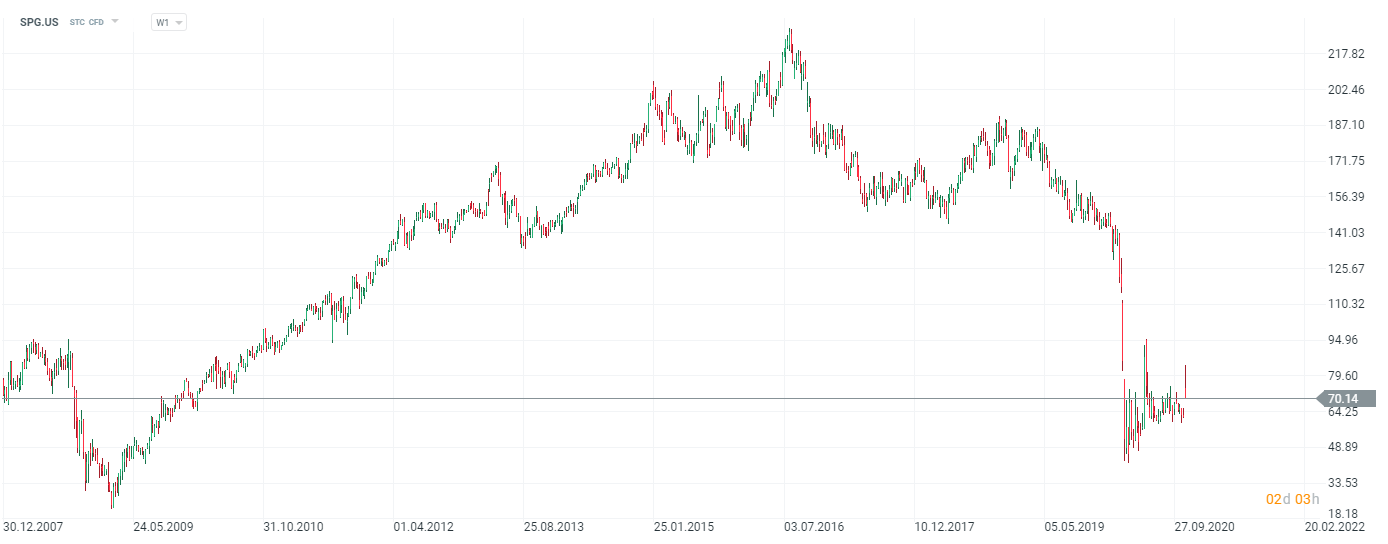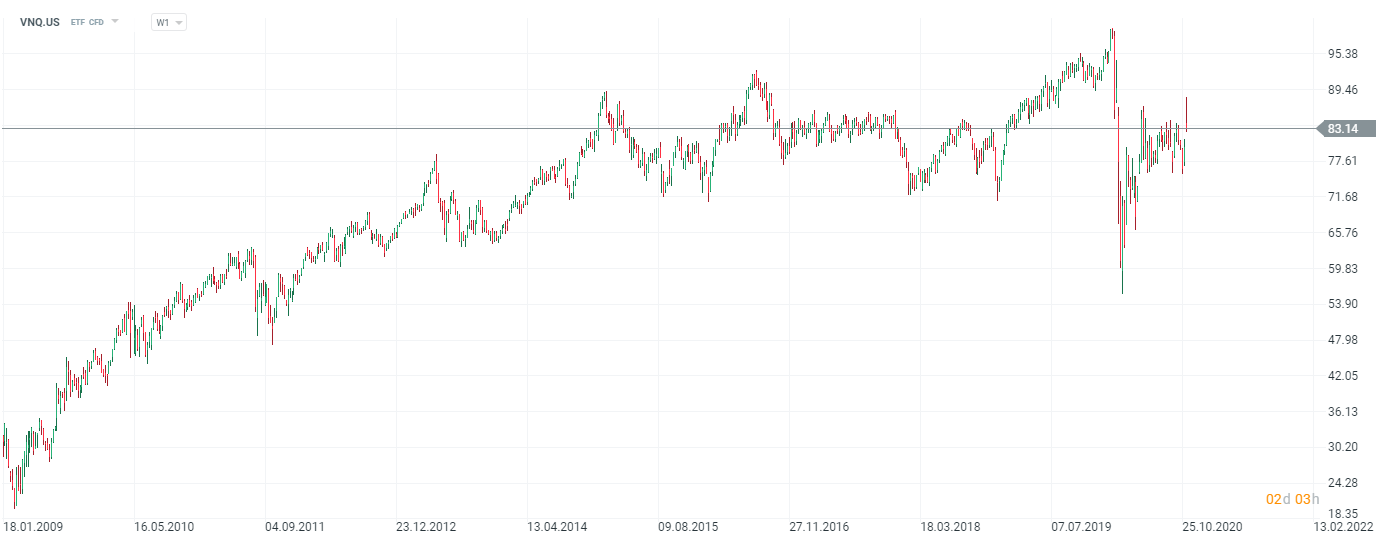What is a REIT - how to invest in it [GUIDE]
Investing in real estate is usually associated with buying a rental apartment or building plot. It is the most popular way of investing in real estate by Polish households. Unfortunately, as a rule, such investments are not geographically diversified. They usually concern one country, and sometimes only one poviat. Due to financial constraints, self-investing focuses on low-value real estate. Investing in data centers, offices, shopping centers is beyond the financial reach and competence of most individual investors. The solution is to invest in a REIT that allows you to acquire shares in the best real estate around the world. All you need is access to foreign markets.
History
REITs are an increasingly popular form of business organization in the United States. REIT is different Real Estate Iinvestment Trust. It is a business that owns, operates or finances income-generating real estate.
This formula was established in 1960 with the signing of Real Estate Investment Trust Act. From that moment on, the investor could buy shares in the commercial real estate portfolio. In the beginning, they were mainly shopping centers. At the end of the 60s, railway REITs (e.g. with traction) appeared. Even today, a representative of this type of REIT is listed on the American stock exchange. It is a Power REIT company (ticker: PM).
Modern REITs were created along with the 1986 tax reform. Then the REIT obtained the right to manage and operate the real estate. Previously, they were mainly used to own and finance real estate. In the following years, the number of industries in which REITs operate grew larger. An example is Getty Realty, which is listed on the stock exchange. The company owns, rents and finances shops, gas stations and car washes.
Requirements that must be met by REITs
To qualify as a REIT in the United States, a company must meet the following requirements:
- Must be in one of the 50 states or in the District of Columbia
- Have negotiable stocks or investment certificates
- In the first year from the foundation, have at least 100 investors
- The enterprise cannot be a bank or an insurance company
- It pays at least 90% of profits in the form of dividends
- Rule 5/50 must be met, i.e. the top 5 investors cannot own more than 50% of the shares
- 75% of gross profit must come from real estate activities (rental income, real estate financing)
- 75% of assets invested in the real estate segment (real estate, loans, MBS)
Types of REITs
The Real Estate Investment Trust can be broken down into how and by whom shares can be acquired. Can distinguish:
- Public, admitted to trading - these are REITs whose shares can be bought and sold on the stock market. The REIT is registered with the SEC (the American equivalent of the KNF). About 200 representatives of companies of this type are listed on the American stock exchange. Some of the REITs are components of such indices as S&P 500, S&P 400 or Russell 2000.
- Public, not admitted to trading - this type of REITs is known as PNLR (Public Non-Listed REIT). This type of company is registered with the SEC, but the shares are not publicly traded. Nevertheless, REITs have the right to carry out share buyouts. In turn, investors can buy and sell over-the-counter market shares privately. The minimum investment in these types of companies ranges from $ 1000 to $ 2500.
- Private: These are trusts that are not registered with the SEC. For this reason, they are not admitted to exchange trading. As a result, they are purchased by institutional investors.
Another division is the type of assets owned by the Real Estate Investment Trust. These are:
- Equity REITs - this is the most numerous type. They own, manage and operate income-generating real estate. The main income comes from rental fees from tenants. Another source of revenue is management fees.
- Mortgage REITs - it is an interesting type of enterprise. They focus on providing financing in the real estate market. These can be investments in Mortgage Backed Securities (MBS) or arranging direct loans. The main profit is generated from the net interest margin, i.e. the difference between the interest on invested funds and the cost of financing the investment.
- Hybrid REITs - this is a combination of both previous REITs. Such companies have both a real estate portfolio and a real estate finance business segment.
Industries in which REITs operate
REITs operate in many different industries, including:
- Shopping centers
- Data centers
- Healthcare
- Offices
- Industrial buildings
- Infrastructure
- Telecommunication
- Prisons
How to invest in REITs?
This is definitely an interesting investment idea. A good representation of the potential gains from the real estate market is the S&P Global REIT index, which over the past 10 years has achieved a total return (after dividends, before tax) of 7%. The price increase of the index alone amounted to 2,6%. The difference is due to the construction of REITs, which must pay out most of their profits in the form of dividends, which increases the rate of return achieved by the investor. The table below shows the average annual rate of return (CARG%) as of November 10, 2020.
| CARG% | 3 years | ||
| S&P Global REIT | 7,04% | 4,61% | 2,11% |
| S & P 500 | 13,59% | 13,49% | 13,33% |
| S&P Global 1200 | 9,81% | 11,01% | 9,44% |
The most popular ways to invest money in REITs are:
- REITs listed on the stock exchange
- ETFs
Stocks and ETFs in the REIT market
Simon Property Group (SPG)
It is one of the components the S&P 500 index. It is the largest fund operating as the owner and operator of shopping centers in the USA. At the end of 2019, they held shares in 204 properties (including 106 shopping centers, 69 Premium Outlets, 4 lifestyle centers) operating in the USA. Simon is present in 37 states and Puerto Rico. SPG also has interests in 29 facilities in Asia, Europe and Canada.
The company generates most of its revenues from fixed fees depending on the size of the space leased and the sales achieved by the tenant. For many years it was a stable company which, due to being a REIT, generously shared its profits with shareholders. Due to its activities, the company is sensitive to the financial situation of its tenants. As a rule, the company had no major problems with filling its shopping centers. The situation began to change in March 2020. COVID-19 reduced traffic in shopping centers, which had an impact on the solvency of sellers. The company said it collected only 51% of rents in the May-April period. In Q2020 1,06, the company's revenues amounted to $ 25 billion, which meant a decrease of over 73%. Net income declined by more than 145,9% to $ 50 million. The deteriorating condition of tenants affected the SPG price, which fell by over XNUMX% over the year.

Simon Property Group chart, interval W1. Source: xNUMX XTB.
Vanguard Real Etf (VNQ)
Another way to invest in REITs is to buy ETF with exposure to this real estate segment. An example is Vanguard Real Estate ETF groups over 180 companies operating as REITs. It is a benchmark for the ETF MSCI US Investable Market Real Estate 25/50 Index.
- Issuer: Vanguard
- Assets under management (AUM): $ 29,96 billion
- Annual fees: 0,12%
- Average daily turnover (45 days): $ 335,3 million
Here is a list of the top 10 ETF positions at the end of Q2020 XNUMX
| Vanguard Real Estate II Index Fund | 12,3% |
| American Tower Corporation | 8,5% |
| Prologis Inc. | 5,9% |
| Crown Castle International Corporation | 5,5% |
| Equinix Inc. | 5,3% |
| Digital Realty Trust Inc. | 2,9% |
| SBA Communications Corporation | 2,8% |
| Public storage | 2,7% |
| Welltower Inc. | 1,8% |
| Weyerhauser Corporation | 1,7% |
The ETF is very well diversified and has exposure to both the data center market, telecommunications and healthcare sectors. The ETF also includes the Simon Property Group with a 1,56% share.

Vanguard Real Estate ETF Chart, Interval W1. Source: xNUMX XTB.
Advantages and disadvantages of investing in a REIT
Advantages
Investing in REITs allows the investor to diversify his portfolio with high-quality real estate. In the case of purchasing listed REITs or ETFs, the investor also gains a very high liquidity of their assets. This is one of the benefits that, for example, apartments for rent cannot provide. Another advantage is the possibility of investing in the development of market segments inaccessible to the "ordinary investor". An example is the market of data centers or prison operators. Their next advantage over the "ordinary" real estate investment is geographical diversification. It is also an interesting position for investors looking for assets to add to their dividend portfolio.
Disadvantages
When investing in individual REITs, it is essential to understand the business of the company. Simon Property Group, which suffered during the coronavirus, can be given as an example. In turn, Equinix, whose business of building and managing data centers has not been "infected" COVID-19. For some investors, the disadvantage of investing in REIT assets is the need to pay a high dividend. Due to the need to share 90% of profits with investors in the form of dividends, the development of companies of this type requires the use of external financing. This limits the scaling potential and increases leverage and interest costs. In addition, it would be more beneficial for long-term investors to buy back shares, which would avoid the need to pay tax on dividends. Another downside is market volatility, which is "not visible" on the classic real estate market.






















![Forex Club – Tax 9 – Settle tax on a foreign broker [Download the Application] Forex Club - Tax 9](https://forexclub.pl/wp-content/uploads/2024/02/Forex-Club-Podatek-9-184x120.jpg?v=1709046278)
![Trading View platform – solutions tailored to the needs of traders [Review] trading view review](https://forexclub.pl/wp-content/uploads/2024/03/trading-view-recenzja-184x120.jpg?v=1709558918)
![How to connect your FP Markets account to the Trading View platform [Guide] fp markets trading view](https://forexclub.pl/wp-content/uploads/2024/02/fp-markets-trading-view-184x120.jpg?v=1708677291)
![How to invest in ChatGPT and AI? Stocks and ETFs [Guide] how to invest in chatgpt and artificial intelligence](https://forexclub.pl/wp-content/uploads/2023/02/jak-inwestowac-w-chatgpt-i-sztuczna-inteligencje-184x120.jpg?v=1676364263)




![Izabela Górecka – “Success on the market depends not only on knowledge, but also on emotional stability” [Interview] Izabela Górecka - interview](https://forexclub.pl/wp-content/uploads/2024/04/Izabela-Gorecka-wywiad-184x120.jpg?v=1713870578)
![WeWork – the anatomy of the collapse of a company valued at $47 billion [WeWork, part II] wework bankruptcy story](https://forexclub.pl/wp-content/uploads/2024/04/wework-bankructwo-historia-184x120.jpg?v=1711729561)
![Adam Neumann – the man who screwed up Softbank [WeWork, part AND] adam neumann wework](https://forexclub.pl/wp-content/uploads/2024/04/adam-neumann-wework-184x120.jpg?v=1711728724)




![The most common mistakes of a beginner trader - Mr Yogi [VIDEO] Scalping - The most common mistakes of a beginner trader - VIDEO](https://forexclub.pl/wp-content/uploads/2024/03/Scalping-Najczestsze-bledy-poczatkujacego-tradera-VIDEO-184x120.jpg?v=1711601376)
![Learning patience: No position is also a position - Mr Yogi [VIDEO] Scalping - Learning patience - No position is also a position - VIDEO](https://forexclub.pl/wp-content/uploads/2024/03/Scalping-Nauka-cierpliwosci-Brak-pozycji-to-tez-pozycja-VIDEO-184x120.jpg?v=1710999249)
![When to exit a position and how to minimize losses - Mr Yogi [VIDEO] Scalping - When to exit a position and how to minimize losses - VIDEO](https://forexclub.pl/wp-content/uploads/2024/03/Scalping-Kiedy-wyjsc-z-pozycji-i-jak-minimalizowac-straty-VIDEO-184x120.jpg?v=1710336731)



![What is a REIT - how to invest in it [GUIDE] REIT - real estate investment trust](https://forexclub.pl/wp-content/uploads/2020/11/REIT-real-estate-investment-trust.jpg?v=1605255279)


![How to invest in ChatGPT and AI? Stocks and ETFs [Guide] how to invest in chatgpt and artificial intelligence](https://forexclub.pl/wp-content/uploads/2023/02/jak-inwestowac-w-chatgpt-i-sztuczna-inteligencje-300x200.jpg?v=1676364263)
![What is a REIT - how to invest in it [GUIDE] synctrading teletrade test 6](https://forexclub.pl/wp-content/uploads/2020/11/synctrading-teletrade-test-6-102x65.jpg?v=1605086705)
![What is a REIT - how to invest in it [GUIDE] forex swiss prime warning](https://forexclub.pl/wp-content/uploads/2020/11/ostrzezenie-forex-swiss-prime-102x65.jpg?v=1605259977)










Leave a Response